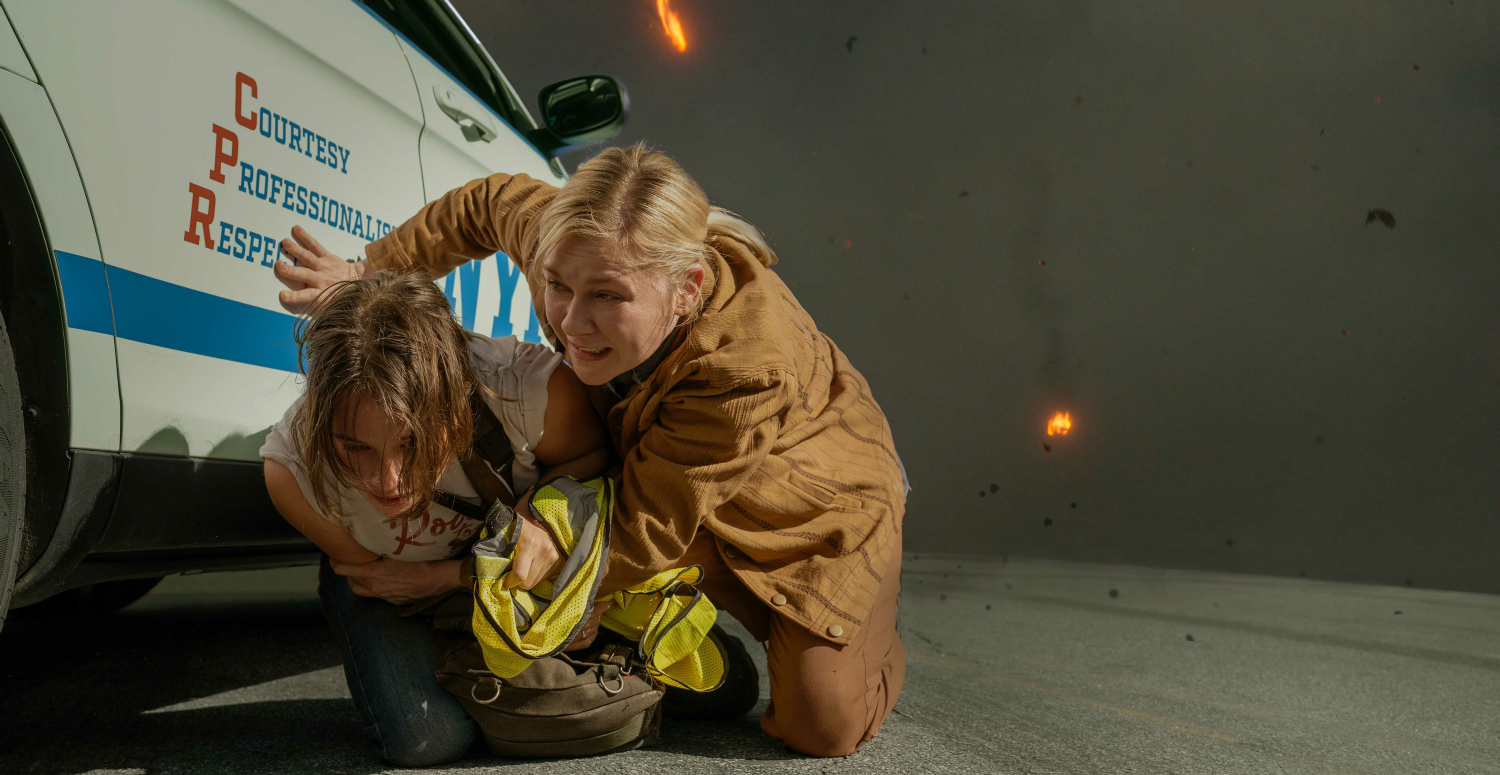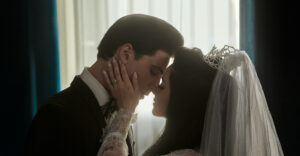Civil War
Best Effects – BIFA
Best Sound – BIFA
Best Supporting Photoreal Visual Effects – VESA
2024

FR EN
A l’approche des élections présidentielles américaines en novembre prochain, une histoire de guerre civile contemporaine sur le sol états-unien promettait de décortiquer les failles d’une nation en déliquescence dans un film de guerre et politique qui mettrait en exergue les profondes divisions actuelles du pays. Mais aussi bien la dimension politique, qu’épique de cette œuvre se révèlent trompeuses tant le nouveau film du romancier, scénariste et réalisateur britannique Alex Garland (Ex Machina) se révèle être une œuvre anti-guerre avant tout portée sur le journalisme.
Écrit durant les premiers mois de la pandémie, soit avant l’assaut du Capitole de janvier 2021, « Civil War » met en scène la sombre réalité d’un futur proche à travers une représentation réaliste, froide, et percutante de la guerre. Ce n’est pas une dystopie, c’est un film de guerre au point de vue impartial avec un parti pris sur les conflits armés qui ne cherche aucunement à glorifier la violence. Un film sur la déshumanisation de la guerre. L’accent est donc plutôt mis sur les aspects durs et traumatisants du conflit, montrant ce phénomène pour ce qu’il est, une tragédie, plus que pour quoi il se produit. Bien que spectaculaire dans sa mise en scène, le film ne cherche pas le sensationnel. En nous faisant ressentir la violence de manière viscérale, il ne nous pousse pas à soutenir un camp ou un autre de sorte à ce que personne (quel que soit son bord politique) ne puisse encourager un tel conflit – c’est là tout le sens du film. Il détourne ainsi l’attention des causes et racines de la guerre pour se concentrer sur un point de vue extérieur, celui du groupe de journalistes qui sont les protagonistes de cette histoire, car la vraie arme de ce film n’est autre que l’appareil photo.
L’objectif du film est alors une interview convoitée par une équipe de reporters. C’est un road movie dont le fil rouge devient la relation entre une photographe de guerre chevronnée et sa collègue débutante incarnées par la première héroïne de Sofia Coppola et la dernière en date, Kirsten Dunst & Cailee Spaeny – aux côtés de Wagner Moura et Stephen McKinley Henderson –, deux personnages que ce voyage à travers les États-Désunis d’Amérique va véritablement changer.

“On témoigne pour que les gens posent des questions.”
C’est dans cette réplique que réside la lecture d’un film qui à l’image de son propos, ne cherche pas à donner de leçons mais encourage plutôt les spectateurs à aborder l’intrigue avec un esprit ouvert et à s’interroger eux-mêmes. C’est un film sur l’impartialité de la presse, qui questionne avant tout le sens de l’information, la fonction du journalisme, et la neutralité de la retranscription des événements. Il met en scène des reporters photos dont le travail n’est pas de traiter des questions éthiques inhérentes au conflit, mais plutôt de l’enregistrer le mieux possible ; nous interrogeant ainsi sur le pouvoir de l’image, l’absolue nécessité de préserver un journalisme de terrain capturant le réel, ainsi que sur la frontière entre cette nécessité et la dimension artistique que représente la photographie de guerre. « Civil War » s’impose donc comme un hommage aux journalistes et photographes, en particulier Don McCullin et Lee Miller.
“Quel genre d’Américains, vous êtes ?”
Ce point de vue neutre laisse évidemment un flou idéologique et contextuel dans la mesure où on ne sait pas vraiment ni quand, ni pourquoi, ni comment a débuté cette guerre. C’est au public de décider. Bien qu’il y ait quand même quelques éléments de contextualisation politique, technologique, ou économique avec notamment un état des lieux succinct de la nation alors divisée entre les États loyalistes, ceux du Nord-Ouest, l’Alliance de Floride, et les Forces de l’Ouest composées du Texas et de la Californie – ce qui peut apparaître à première vue comme une réalité improbable nous renvoyant à l’image même de la guerre sur le sol occidental. Ce flou politique est prolongé jusque dans les combats pour souligner la nature autoentretenue de la guerre. Lorsque la situation devient extrême, les raisons n’importent plus, la guerre en est alors réduite à “nous vs eux” et on n’en vient à ne plus savoir pourquoi l’on se bat. Le film ne nous laisse ainsi même pas savoir qui tire sur qui ou pourquoi, et ne nous indique pas non plus dans quel camp, ni même s’il en a un, se trouve un soldat non identifié (Jesse Plemons) terrorisant nos protagonistes.

Cinquante millions de dollars de budget …
« Civil War » représente à ce jour la plus grosse production du studio indépendant à grand succès de ces dernières années A24, et ce budget conséquent pour un film de cette gamme se ressent tant le film donne l’impression de disposer de deux ou trois fois plus. Dans une approche naturaliste, les scènes d’action ont été filmées à l’aide de petites caméras portatives amplifiant la dimension viscérale, immersive et réaliste du film. Un réalisme fait d’incertitude pour l’ensemble des personnages qui nous tient en haleine jusqu’au bout. Alex Garland signe ici, sa mise en scène la plus impressionnante, maintenant une tension continue tout en rendant à la fois ce conflit spectaculaire – par une magnifique photographie – et traumatisant – grâce à un fin travail de mixage son et un puissant jeu sur les silences. Comme souvent chez Garland, un rythme lent se met en place pour installer une atmosphère, une image forte, symbolique ou surréaliste reflétant la nature même du combat comme lors d’un duel de snipers au milieu de décorations de Noël laissées à l’abandon dans un décor bucolique. Certaines scènes se révèlent par ailleurs particulièrement marquantes par leur violence, leur tension ou simplement la peur qui s’en dégage faisant de « Civil War » un film qu’on n’oublie pas.
Un film fort, émouvant et magnétique. Un film sur le conflit et sa couverture qui nous invite à le voir de manière apolitique.
Ahead of the U.S. presidential elections in November, a contemporary civil war story set on U.S. soil promised to unravel the flaws of a failing nation in a political war film that would highlight the country’s deep divisions. But both the political and epic dimensions of this film prove deceptive, as the new film by British novelist, screenwriter and director Alex Garland (Ex Machina) turns out to be an anti-war piece primarily about journalism.
Written during the first months of the pandemic, that is, before the assault on the Capitol in January 2021, “Civil War” depicts the grim reality of a near future through a cold, hard-hitting, realistic portrayal of war. This is not a dystopia, but a war film with an impartial point of view and a critical take on armed conflict that in no way seeks to glorify violence. It’s a film about the dehumanization of war. The focus is therefore rather on the harsh, traumatic aspects of the conflict, depicting it for what it is – a tragedy – rather than for why it happens. Although spectacularly executed, the film is not driven by the spectacle. By making us feel the violence in a visceral way, it doesn’t make us cheer for one side or the other, so that no one (regardless of political views) can root for such a conflict – that’s precisely the point of the film. In this way, it keeps the focus away from the causes and roots of the war to instead take an external viewpoint, that of the group of journalists who are the protagonists of this story, because the real weapon of this film is none other than the camera.
The film’s goal is then to get a highly sought-after interview from a team of reporters. It’s a road movie whose main storyline becomes the relationship between a seasoned war photographer and her rookie colleague, played by Sofia Coppola’s first and latest heroines, Kirsten Dunst & Cailee Spaeny – alongside Wagner Moura and Stephen McKinley Henderson – two deeply changed characters by their journey across the Divided States of America.

‘We record so that other people ask.’
This line is the key to a film which, like its subject matter, does not preach, but rather urges viewers to look at it with an open mind, and to make their own inquiries. It’s a film about the impartiality of the press, questioning above all the definition of information, the role of journalism, and the neutrality of reporting. It features photo reporters whose job is not to address the ethical issues inherent in this conflict, but rather to record it as best they can; thereby questioning the power of the picture, the absolute necessity of preserving on-the-ground journalism that captures reality, and the boundary between this necessity and the artistic edge that war photography brings. “Civil War” is therefore a tribute to journalists and photographers, in particular Don McCullin and Lee Miller.
‘What kind of American are you?’
This unbiased point of view obviously leaves an ideological and contextual blur, insofar as we don’t really know when, why or how this war began. It’s up to the audience to decide. Although there are a few elements of political, technological and economic contextualization, including a brief overview of the nation divided between the Loyalist States, the Northwest, the Florida Alliance and the Western Forces made up of Texas and California – which at first glance may seem an unlikely reality, reflecting the very essence of war on Western soil. This political vagueness is extended right into the fighting, to underline the self-perpetuating nature of the war. When things get extreme, the reasons no longer matter, the war is boiled down to “us vs. them”, and we no longer know what we’re fighting for. As a result, the film doesn’t even tell us who’s shooting at whom or why, nor does it tell us which side an unidentified soldier (Jesse Plemons) terrorizing our protagonists is on, or even if he has one.

A fifty-million-dollar budget…
“Civil War” is currently the biggest production to date from the highly successful independent studio A24, and its sizeable budget for a film of this calibre is palpable as the film feels like it had two or three times as much budget. In a naturalistic approach, the action scenes were filmed using small hand-held cameras, enhancing the film’s visceral, immersive and realistic dimension. A sense of realism built on uncertainty for all the characters, which keeps us on the edge of our seats right to the end. This is Alex Garland’s most impressive directorial effort, building sustained tension while at the same time depicting the conflict as both breathtaking – thanks to gorgeous cinematography – and shocking – thanks to subtle sound mixing and a powerful use of silence. As is often the case with Garland’s work, a slow pace is set up to create an atmosphere, a strong, symbolic or surreal imagery that reflects the very nature of the battle, as during a sniper duel in the midst of Christmas decorations left abandoned in a bucolic environment. Some scenes are also particularly striking for their violence, their tension or simply the fear that emanates from them, making “Civil War” a film you won’t forget.
This is a powerful, moving and magnetic picture. A film about conflict and its reporting that challenges us to see it apolitically.

